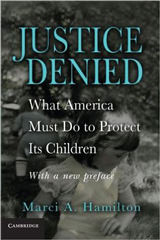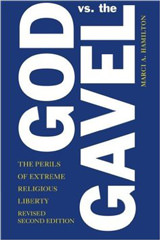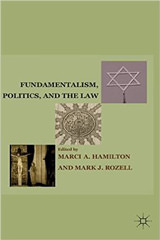In my last Justia column, I set out the extreme nature of the Religious Freedom restoration Act (RFRA). To summarize, a RFRA is an extraordinary power grab by religious entities. It gives them the capacity to challenge neutral, generally applicable laws with standards never employed under the First Amendment. Again: the “restoration” in its title is rhetoric, not reality.
Despite the RFRA’s extreme nature, however, those seeking its shelter have argued recently for two radical extensions. In Part I in this series of columns, I analyzed the argument that for-profit corporations may claim RFRA rights (an argument that will be tested in the contraceptive mandate-cases, pending at the Supreme Court, that are to be argued next Tuesday). I then explained how the law of corporations, Title VII, and the RFRA legislative history undermine such claims.
Now, I turn to Part II in this series, in which I will discuss the other current extreme demand: the argument that RFRAs should be extended to suits between private parties, beyond their indisputable coverage of disputes between the government and a believer. This issue has surfaced primarily in the states, where purportedly rampant fear by bakers and florists of having to deal with same-sex couples has led to proposals to give businesses a RFRA defense that could be invoked against potential customers.
The most controversial such bill was eventually vetoed by Arizona’s Governor, Jan Brewer. That bill would have permitted private businesses to raise the state RFRA as a defense in lawsuits by those customers they have turned away. The bill would have rolled back the state and city public accommodations laws that forbid discrimination by private business entities on the basis of race, gender, sexual orientation, alienage, and disability. In a thoroughly unpersuasive letter justifying this ugly law, which was posted on National Review Online, a group of scholars asserted that “nothing in the amendment would say who wins” these cases.
True enough, but in fact the RFRA claim gives the believer business owner a club to pound the public accommodations law into submission. The believer must prove that the law imposes a “substantial burden,” but believers are telling us that “complicity” in others’ actions is a substantial burden, so the religious lobbyists certainly don’t see that as a barrier. Then the government has to prove that the law serves a compelling interest. I hope that deterring and punishing discrimination based on race, gender, sexual orientation, alienage, and disability are compelling interests, though there are inklings in the RFRA legislative history in 1997-1999 that some thought only deterring race discrimination was likely to rise to a compelling interest.
As I discussed in Part I, however, the most disturbing element of the RFRA formula that makes it so powerful for believers (and so not a part of the prior law) is that the government must prove that the law is the “least restrictive means” for this particular believer. This is true in the Arizona RFRA, as well as the federal. It is the element, in a nutshell, that turns liberty into narcissism, as I discussed in this Justia column. So, let’s ponder for a moment what would be the “least restrictive means” for the believer who does not want to have do to business with homosexuals or women or minorities. How about this: It would be less restrictive for the believer to send them to another baker or florist or restaurant. No, wait, by directing them to another, the baker or florist or restaurant might be “complicit” in the sinfulness of assisting them in getting married, or just being who they are, so they can’t be expected to help these customers. Thus, an even less restrictive means would be a right to simply refuse to do business with them and let them find their own baker or florist or restaurant.
And there you have it: the “least” restrictive means is whatever a court’s imagination can conjure up. So please don’t tell us that the extreme Arizona bill would not have placed a heavy thumb on the side of the businesses’ scale.
RFRA’s Plain Language Limits It to Suits Involving the Government Alone
When it comes to RFRA, we are dealing with a statute and when the courts interpret statutes, they must first examine the text, and the plain language controls.
The RFRA text is not ambiguous: the government is mentioned prominently: it is explicitly forbidden from imposing a substantial burden it is the entity that must demonstrate that the burden furthers a compelling interest vis-à-vis the least restrictive means; and it is the only entity from which a claimant can “obtain appropriate relief.”
In General. Government shall not substantially burden a person’s exercise of religion even if the burden results from a rule of general applicability, except as provided in subsection (b) of this section.
Exception. Government may substantially burden a person’s exercise of religion only if it demonstrates that application of the burden to the person-(1) is in furtherance of a compelling governmental interest; and (2) is the least restrictive means of furthering that compelling governmental interest.
Judicial relief. A person whose religious exercise has been burdened in violation of this section may assert that violation as a claim or defense in a judicial proceeding and obtain appropriate relief against a government. Standing to assert a claim or defense under this section shall be governed by the general rules of standing under Article III of the Constitution.
(emphasis added)
When the issue is whether there is a cause of action, the courts are particularly constrained by legislative intent, as the Court emphasized in Hartford Underwriters Ins. Co. v. Union Planters Bank (2000) and Touche Ross & Co. v. Redington.
The courts to reach the issue have found this language impossible to ignore, and have found that RFRA is not available in disputes between private parties, including the Sixth Circuit in General Conference Corp. of Seventh-Day Adventists v. McGill and the Second Circuit in Rweyemamu v. Cote. In an earlier Second Circuit case, where the court only touched on the issue in dictum, then-Judge Sonia Sotomayor, in her dissent, stated that RFRA’s language leads to the conclusion that it could only be applicable in suits involving the government. Hankins v. Lyght. Similarly, the Ninth Circuit has held that a private employee cannot not assert a RFRA action against a private employer, in Sutton v. Providence St. Joseph Med. Ctr. The Seventh Circuit also has expressed this view in dictum in Tomic v. Catholic Diocese of Peoria.
The Legislative History of RFRA Does Not Support Ignoring the Plain Language and Extending It to Disputes Between Private Parties
Some have argued that RFRAs should apply to disputes between private parties, despite its language. If the language were ambiguous, which it is not, the next question would be what the legislative history showed. Again, though, the legislative history provides no solace for those attempting to expand the RFRA formula to every conceivable dispute possible, whether the government is involved or not.
After the federal RFRA was held unconstitutional in Boerne v. Flores, religious entities turned back to Congress, as I discussed in Part I of this series of columns. Part of this new congressional push involved the ACLU and civil rights groups fighting for an exemption from RLPA for the civil rights laws. Why? Because there were several cases under RFRA involving religious landlords who refused, on religious grounds, to rent apartments to unmarried couples, and the civil rights groups expected similar arguments against single mothers and same-sex couples. In those cases, the claims were between the local or state fair housing commission and the landlord. In other words, RFRA was invoked in disputes involving the government. They did not involve disputes solely between private parties. And the examples discussed always involved facts where the government, e.g., the EEOC, would be involved. There is nothing in the language or legislative history that shows a conscious decision to create rights for private party disputes.
The recent spate of proposals across the country to add a provision to a state RFRA that permits such private party disputes also argues against finding that private party disputes were ever intended to be covered by the RFRA formula. Why would these states, like Arizona, with standard RFRAs need additional language affording private business owners the capacity to raise RFRA against their private customers if a RFRA already covered it?
Free Exercise Doctrine Does Not Open the Door to Private Party Disputes, Either
While RFRA exceeds the reach of prior constitutional doctrine, as I demonstrated in Part I, it is supposedly intended to “restore” the Court’s constitutional doctrine. That would mean that it should be worthwhile to look back to prior Supreme Court free exercise cases to see whether those cases involved rights that were invoked by private parties against private parties. There aren’t any.
Some have pointed out that there are a few cases that involve the First Amendment’s freedom of the press in defamation disputes between private parties. The first such case, New York Times v. Sullivan, was not wholly private, but rather involved a public official, Montgomery Public Safety Commissioner Sullivan. Its reasoning was modified in other cases involving the press, defamation, and purely private entities. Cox Broadcasting v. Cohn. But this extension of the First Amendment’s Press Clause into private disputes has not been followed in the speech or religious conduct cases. Nor should it be. It is a remarkably weak prop to overcome plain language and the lack of RFRA cases involving solely private parties.
RFRA’s Constitutional Problems Argue in Favor of Defining Its Reach Narrowly
As I argued in the Boerne case and in my recent amicus brief to the United States Supreme Court, RFRA violates the separation of powers, Art. V, and the Establishment Clause. The Court has never addressed RFRA’s constitutionality since Boerne invalidated it, or after it was re-enacted to apply to federal law in 2000, because the federal government typically does not challenge its own laws and the religious claimants certainly won’t challenge RFRA.
Even so, it is important to remember that RFRA did not get a clean bill of health in Boerne, and the Court’s concerns were not solely limited to its application to the states. First, Justice Kennedy, writing for the majority, recognized that the federal government cannot create constitutional rights against the federal government (without following Article V procedures).
Second, the Court turned to the question whether the federal government could create constitutional rights against the states, and answered, again, in the negative. Congress may, under Section 5 of the Fourteenth Amendment, enforce existing constitutional rights against the states, but Sec. 5 of the Fourteenth Amendment had not “endowed Congress with the power to establish the meaning of constitutional provisions.” With RFRA, according to the Court, Congress unilaterally usurped that authority: RFRA “appears . . . to attempt a substantive change in constitutional protections.” Thus, RFRA is a violation of the separation of powers.
Third, RFRA is a violation of the constitutional amendment process. The Court invalidated RFRA because it was an attempt to create, through simple majority vote, a constitutional change.
Finally, RFRA raises quite serious Establishment Clause issues, both facially and as applied. There was no need for the full Boerne Court to reach the Establishment Clause arguments, but Justice Stevens, in concurrence, voiced the still-live concern that RFRA provides the “Church a legal weapon no atheist or agnostic can obtain.” This is a law that gives believers the ability to use the federal courts to overcome the neutral, generally-applicable laws that apply to everyone else, with attorneys’ fees thrown in, and it does so with the extreme “least restrictive means” test, which means that believers can demand that the law be shaped to them individually. The government has departed from the wholesome neutrality toward religion prescribed by the Establishment Clause.
Given these constitutional problems lurking in the shadows behind RFRA, there is very good reason to avoid extending it beyond its actual language, and to tread carefully before further expanding it.
Finally, beyond the constitutional concerns, there is a deeply important policy reason to read RFRA narrowly, especially when the question is whether it can be used for legal combat between private parties, e.g., neighbors, businesses and their would-be customers, and even strangers. The insatiable push for more and more religious freedom is unsettling, but it is a reminder that there is no natural limit to the demands of religious prerogative or to believers’ capacity to harm others or the community as a whole. I believe the New Testament says it well: “You will know them by their fruits.” RFRA’s most recent fruit is none too sweet, which tells us something about RFRA itself.









